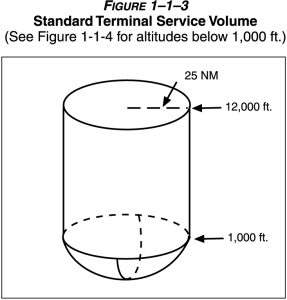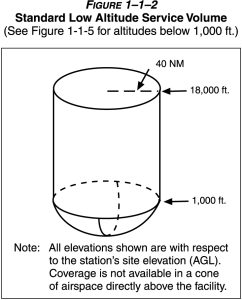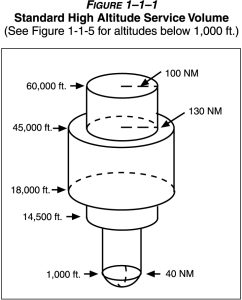VORs are anything but standard. When operating under the guidance of radio navigational aids like a VOR it’s important to understand the restrictions and standard service volumes (SSV) associated with each aid of intended use. VOR standard service volumes are designated in three classes: Terminal (T), Low Altitude (L), and High Altitude (H). Your aeronautical charts will at minimum show position, frequency, and Morse code identifier of each VOR; you can find additional information like the SSV in your AF/D.
Terminal VOR (TVOR) has a range of 25NM from 1,000 feet AGL to 12,000 feet AGL.
Low Altitude VOR (LVOR) has a range of 40NM from 1,000 feet AGL to 18,000 feet AGL.
High Altitude VOR (HVOR) is a little trickier and has several different service volumes based on altitude. The first of these starts at 1,000 feet AGL up to 14,500 feet AGL with a range of 40NM. As we increase in altitude so does range, from 14,500 feet AGL up to 18,000 feet—a range of 100NM. Then again, range will increase to 130NM from 18,000 feet up to 45,000 feet. Once we get over 45,000 feet the range will decrease back down to 100NM up to 60,000.
A VOR allows for high quality line of sight reception so even though you may be within the SSV of a particular VOR you are not guaranteed reception. This would be caused by local terrain features surrounding the ground station. Furthermore, it’s important to check NOTAMs prior to using any VOR for navigational purposes as often happens a VOR may be placed out of service. You can see from the NOTAM below how the Santa Monica VOR is shown to be out of service from February 10, 2015 at 1600 until March 14, 2015 at 2359.
!SMO 02/013 SMO NAV VOR/DME OUT OF SERVICE 1502101600-1503142359
More commonly, a VOR may have further range and boundary restrictions imposed. This can occur for a number of reasons, something as simple as a crane being erected near the ground station causing blockage of a select range of radials.
For further information on VORs you can refer to ASA’s publication of the Aeronautical Information Manual. Or check out the Navigation section of the Learn to Fly Blog for more posts on VORs.








